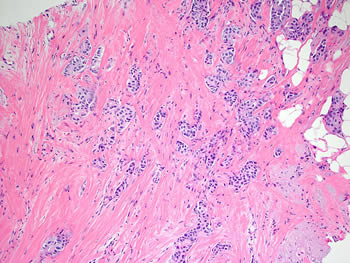Diagnosis
Diagnosis
The Wilmot Cancer Institute provides the full spectrum of breast cancer care, from initial diagnosis and treatment to recovery and rehabilitation. All of our breast oncologists are specialists in breast disease. Seeking care at Wilmot’s Comprehensive Breast Care at Pluta also ensures convenience and access to integrative therapies such as tai chi, massage and yoga.
We work in multidisciplinary teams. Multidisciplinary means that our providers include experts with a variety of specialties: surgeons, medical oncologists, radiation oncologists, pathologists, radiologists, nurse practitioners, social workers, clinical researchers, and others. They work together on your case to provide the most personalized care possible.
Breast cancer diagnosis
Getting an accurate diagnosis is essential to getting the best treatment. Wilmot is the only provider in the region with in-house pathologists who specialize in diagnosing breast cancer, and who can offer immediate on-site testing for the HER2/neu gene, which is associated with a more aggressive type of breast cancer. Our teams also develop individualized treatment plans that target the cancer while minimizing side effects.
 Breast cancer symptoms
Breast cancer symptoms
Sometimes breast cancer causes no symptoms if the lump is too small to feel. However, it’s important to see a doctor if you do feel a lump, unusual thickening, or swelling in the breast. Other important symptoms include breast or nipple pain; redness, skin irritation or dimpling; nipple discharge other than milk; and a lump in the adjacent underarm area.
How is breast cancer diagnosed?
Imaging: Mammograms, ultrasounds, MRI, and other imaging tests can detect breast tumors, even when they are very small. Imaging tests are used as screening tools if no symptoms are present and as diagnostic tools if cancer is suspected during a physical examination or if a woman finds a lump on her own. If an imaging test detects cancer before symptoms are present, often the cancer is at an early stage (when the tumor is too tiny to feel) and when it's usually more treatable and potentially curable. It's important for women to get recommended screening tests. UR Medicine's Breast Imaging Centers provides advanced digital mammography, breast ultrasound and interventional procedures to detect breast cancer.
Medical history and physical examination: This step includes a complete medical history and assessment of risk factors and symptoms. A doctor also will conduct a clinical breast exam, feeling the breasts and armpits for lumps and other tissue changes.
Biopsy: A biopsy involves removing cells or other tissue for further examination by a pathologist. Breast biopsies can include a fine needle aspiration, a core needle biopsy, or a surgical biopsy.
Pathology: At Wilmot, a specialized breast cancer pathologist will study the tissue from the biopsy under a microscope to look for breast cancer cells. The pathologist can also classify the cancer into specific types, such as hormonal-positive or hormonal-negative disease, and the status of the HER2 gene, as described above.
David G. Hicks, M.D.
Director of Surgical Pathology
Gene expression patterns: Research has shown some new ways to classify breast cancer, based on molecular characteristics. Wilmot oncologists often use advanced diagnostic tests (such as the Oncotype DX gene test for small tumors) to predict whether a breast cancer is likely to recur or spread.